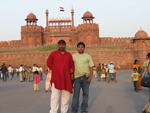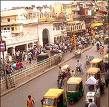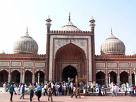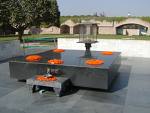Top Tourist Place to Visit in New Delhi
NEW Delhi, India’s national capital is a fusion of the ancient and the modern. The fascinating city reflects a rich culture, boasts of amazing architecture and is seeped in history. It is also a vibrant metropolis, with modern, well-planned office, commercial and residential complexes and colourful bazaars. Interestingly, the capital also generates a mesmerising charm with its well composed and spacious streets under the shade of beautifully lined avenues of trees and tall and imposing government buildings. Explore the wonders of Delhi with a home stay in the city.
Delhi has behind it a great history. Delhi is also known as the heart of India. It is the historic capital of India, where many empires rose and fell before dawn. Delhi has a 5000 years old history. Delhi was the focal point for the first war of independence in 1857. The history of Delhi began with the creation of Indraprastha by the Pandavas. Delhi is full of historical buildings, heritage sites temples etc. The country’s finest museums, whether it is the National Museum, the Craft Museum, the Rail Museum, or the Museum of Natural History and Science, are all in Delhi. Every state of India has its own emporium at New Delhi, where a tourist can buy or select among handicrafts, textiles and jewelry of a particular region.
Here is a glimpse of city’s main attractions
Humayun’s Tomb
Humayun’s Tomb was built by Humayun’s widow, Hamida Banu Begum. Designed by a Persian architect named Mirak Mirza Ghiyas, the structure was begun in 1562 and completed in 1565. The tomb established a standard for all later Mughal monuments, which followed its design, most notably the Taj Mahal . We are quite close to Humayun Tomb also.
Rashtrapati Bhawan
Built with a mix of Western and Indian styles, Rashtrapati Bhavan was originally built for the Governor General of India. Inaugurated in 1931 as the Viceregal Lodge, the name was changed in 1950 after India became a republic. 5 to 10 min
India Gate and Rajpath
Situated along the ceremonial Rajpath avenue (meaning King’s Way) in New Delhi, India Gate is a memorial raised in honour of the Indian soldiers who died during the Afghan wars and World War I. The names of the soldiers who died in these wars are inscribed on the walls. The cenotaph (or shrine) in the middle is constructed with black marble and depicts a rifle placed on its barrel, crested by a soldier’s helmet. Each face of the cenotaph has inscribed in gold the words Amar Jawan (in Hindi, meaning Immortal Warrior). The green lawns at India Gate are a popular evening and holiday rendezvous for young and old alike. 5 to 10 min
Laxminarayan Temple
Also called the Birla Mandir, the Laxminarayan Temple was built by the Birla family in 1938. Along with the temple itself, the name ‘Laxminarayan Temple’ encompasses a large garden with fountains behind it. The temple attracts thousands of devotees on Janmashtami day, the birthday of Lord Krishna.
Gurdwara Bangla Sahib
One of the many Gurdwaras in Delhi, Gurdwara Bangla Sahib is the most visited one in the Delhi area. Millions visit this Gurdwara from all over the world and of all religions to offer their prayers at this elegant yet historical Gurdwara in Delhi. This is not just a sacred Sikh shrine, but also very important to many Hindus .
Qutub Minar
The Qutub Minar is located in a Mehrauli in South Delhi. It was built by Qutb-ud-din Aibak of the Slave Dynasty, who took possession of Delhi in 1206. It is a fluted red sandstone tower, which tapers up to a height of 72.5 metres and is covered with intricate carvings and verses from the Qur’an. Qutub-ud-din Aybak began constructing this victory tower as a sign of Muslim domination of Delhi and as a minaret for the Muslim priest, the muezzin, to call the faithful to prayer. However, only the first story was completed by Qutub-ud-din. The other stories were built by his successor Iltutmish. The two circular stories in white marble were built by Ferozshah Tughlaq in 1368, replacing the original fourth story.
The balconies in the tower are supported by exquisite stalactite designs. The tapering tower has pointed and circular flutings on the first storey and star-shaped ones on the second and third stories.
The Qutub Minar is also significant for what it represents in the history of Indian culture. In many ways, the Qutub Minar, the first monument built by a Muslim ruler in India, heralded the beginning of a new style of art and architecture that came to be known as the Indo-Islamic architecture style. Other monuments around the Qutb complex, are Jamaali Kamaali mosque and tombs, Balban’s tomb and Adham Khan’s Tomb.
Red Fort
The decision for constructing the Red Fort was made in 1639, when Shah Jahan decided to shift his capital from Agra to Delhi. Within eight years, Shahjahanabad was completed with the Red Fort-Qila-i-Mubarak (fortunate citadel) — Delhi’s seventh fort — ready in all its magnificence to receive the Emperor. Though much has changed with the large-scale demolitions during the British occupation of the fort, its important structures have survived.
Salimgarh Fort
Salimgarh Fort, which is now part of Red Fort complex, was constructed on an island of the Yamuna River in 1546. But a gate called the Bahadur Shahi Gate for entry into the Fort from the northern side was constructed only in 1854-55 AD by Bahadur Shah Zafar, the last Mogul ruler of India. The gate was built in brick masonry with moderate use of red sandstone. The fort was used during the Uprising in 1857 and also as Prison which housed Zebunnisa daughter of Aurangzeb and the British imriosned the freedom fighters of INA. The layout of the Red Fort was organized to retain and integrate this site with the Salimgarh Fort through the Bahadur Shah Gate. The fort has been renamed as Swatantrata Senani Smarak and a plque at the entrance to the fort testifies to this effect.
Chandni Chowk
Chandni Chowk, a main marketplace in Delhi, keeps alive the city’s living legacy of Shahjahanabad. Created by Shah Jahan the builder of Taj Mahal, the old city, with the Red Fort as its focal point and Jama Masjid as the praying centre, has a fascinating market called Chandni Chowk. Legend has it that Shah Jahan planned Chandni Chowk so that his daughter could shop for all that she wanted. The market was divided by canals. The canals are now closed, but Chandni Chowk remains Asia’s largest wholesale market. Crafts once patronized by the Mughals continue to flourish there.Chowk is one of the oldest and busiest markets in central north Delhi, India the Laal Quila (The Red Fort) and Fateh Puri Masjid. With the most famous mosque of Delhi Jama Masjid (Delhi) in the vicinity, along with Sis Ganj Gurudwara, Jain Mandir and a lot of small temples, the place witnesses a genuine cultural harmony.
Jama Masjid
The Masjid-i-Jahan Numa, commonly known as Jama Masjid, is the principal mosque of Old Delhi. Commissioned by the Mughal Emperor Shah Jahan and completed in the year 1656, it is one of the largest and best known mosques in India.
Raj Ghat
On the bank Yamuna River, which flows past Delhi, there is Raj Ghat, the final resting place of Mahatma Gandhi, the father of the nation. It has become an essential point of call for all visiting dignitaries. Two museums dedicated to Gandhi are situated nearby.
Shanti Van
Lying close to the Raj Ghat, the Shanti Vana (literally, the forest of peace) is the place where India’s first Prime Minister Jawaharlal Nehru was cremated. The area is now a beautiful park adorned by trees planted by visiting dignitaries and heads of state.
Lotus Temple
The Lotus Temple is a Bahá’í House of Worship, situated in South Delhi and shaped like a lotus. It was built by the Bahá’í community.
Purana Quila
The Purana Quila (Old Fort) is a good example of medieval military architecture. Built by Humayun, with later-day modifications by Sher Shah Suri, the Purana Quila is a monument of bold design, which is strong, straightforward, and every inch a fortress. It is different from the well-planned, carefully decorated, and palatial forts of the later Mughal rulers. Purana Quila is also different from the later forts of the Mughals, as it does not have a complex of palaces, administrative, and recreational buildings as is generally found in the forts built later on. The main purpose of this now-dilapidated fort was its utility with less emphasis on decoration. The Qal’a-I-Kunha Masjid and the Sher are two important monuments inside the fort. It was made by Aqeel in 1853.
Tughlaqabad
When Ghazi Malik founded the Tughlaq Dynasty in 1321, he built the strongest fort in Delhi at Tughlaqabad, completed with great speed within four years of his rule. It is said that Ghazi Malik, when only a slave to Mubarak Khilji, had suggested this rocky prominence as an ideal site for a fort. The Khilji Sultan laughed and suggested that the slave build a fort there when he became a Sultan. Ghazi Malik as Ghiyasuddin Tughlaq did just that: Tughlaqabad is Delhi’s most colossal and awesome fort even in its ruined state. Within its sky-touching walls, double-storied bastions, and gigantic towers were housed grand palaces, splendid mosques, and audience halls.
Yantra Mandir
The Yantra Mandir consists of 13 architectural astronomy instruments, built by Maharaja Jai Singh II between 1727 to 1734.
Safdarjung’s Tomb
The Safdarjung’s Tomb is a garden tomb in a marble mausoleum.
Lodhi Gardens
The Lodhi Gardens is a park spread over 90 acres. It contains architectural works of the 15th century Sayyid and Lodi’s, a Pathan dynasty which ruled much of Northern India during the 16th century.
Nizamuddin Dargah
Nizamuddin Dargah is the Mausoleum of the famous Sufi Saint Nizamuddin Auliya, Delhi.
Sansad Bhavan
Sansad Bhavan or the Parliament of India is a circular building designed by the British architects Sir Edwin Lutyens and Sir Herbert Baker in 1912–1913. Construction began in 1921, and in 1927 the building was opened as the home of the Council of State, the Central Legislative Assembly, and the Chamber of Princes.
National Museum, New Delhi
The National Museum, New Delhi is the largest museum in India. It holds variety of articles ranging from pre-historic era to modern works of art. It is run by the Ministry of Culture, part of the Government of India. The museum is situated on the corner of Janpath and Maulana Azad Road.
Connaught Place
Connaught Place is one of the largest commercial areas in Delhi, India.












